Hearing the word "daisy", most of us imagine a flower with a yellow center and a corolla of narrow white petals.
But botanists call this flower a nyvyanik (Leucanthemum), or a clerk (Chrysanthemum). But chamomile (Matricaria) they call plants with strongly dissected, like dill, leaves and small white flowers with a yellow center (among them there are several types of medicinal chamomiles).
Leucanthemum (Leucanthemum)
All plants in the family have asters with similar inflorescences in structure, but there are also plants from very different families with inflorescences similar to chamomiles.
In order not to guess - a daisy in front of us or some other flower, let's try to consider this variety of daisy-like.
Marigold, or calendula ( Calendula), - wonderful orange “daisies” with a specific aroma, with a diameter of 5-6 cm, sometimes with a dark center. Since ancient times, gardens have been grown calendula officinalis (Calendula officinalis) as an annual medicinal plant, later it became decorative. It propagates well by self-sowing. Many varieties of yellow, orange, apricot, even pink are bred; low and high, but they are usually terry
![]()
Marigold officinalis, or calendula officinalis (Calendula officinalis)
Pyrethrum (Pyrethrum) there are perennials, less often - annual plants. Very popular feverfew pink (Pyrethrum roseum, Chrisanthemum coccineum) - the founder of modern varieties, united under the name pyrethrum hybrid (Pyrethrum hybridum).
These "daisies" are distinguished by large (7-8 cm in diameter) inflorescences of white, pink, red, raspberry color with a yellow center, towering above the rosettes of large beautiful pinnately dissected leaves. Blossom in June-July.
There are varieties Brenda - thick pink E. M. Robinson - pale pink, Bressingham red - raspberry, Kelway’s Ylorious - scarlet. They multiply well by dividing the bushes. Effective in groups, can be used in arrangements.
For curbs, a golden leaf form is often grown. feverfew (Pyrethrum parthenium, chrysanthemum parthenium, Matricaria eximia) - a perennial cultivated as an annual. The bush is compact, highly branched, 15-20 cm high, with deeply cut yellow-green leaves.
Flower baskets are small (2-3 cm in diameter), collected in corymbose inflorescences, reed flowers are white, tubular - yellow. It has a strong specific odor. Well propagated by seeds, cuttings. Self-seeding is observed.
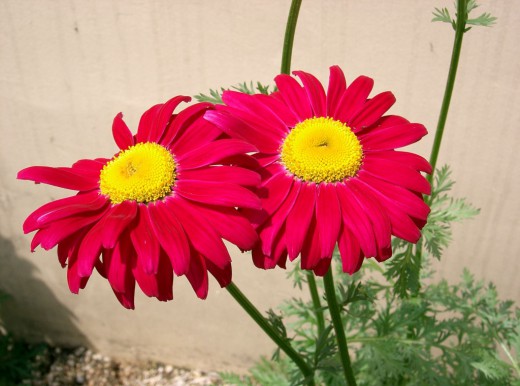
Pyrethrum
Chamomile (Anthemis) also resembles a camomile. Cultivate belly button dyeing (Anthemis tinctoria) - abundantly branching perennial up to 70 cm high.
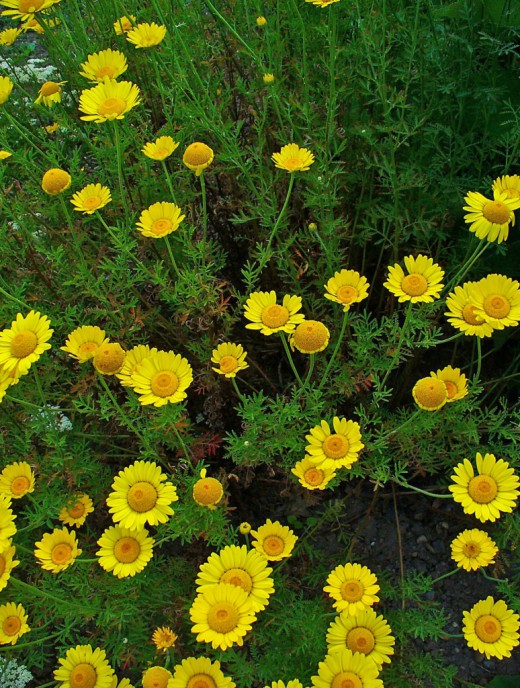
The leaves are large, cirrus-dissected, bluish-green, with pubescence. Inflorescences are yellow baskets up to 4 cm in diameter. It blooms in June and July. After flowering, a short pruning is required to restore the decorativeness of the bushes. The whole plant has a peculiar smell. The navel is propagated by dividing the bush and seeds. Looks good in mixed landings.
To the genus rudbeckia (Rudbeckia) includes perennials, less commonly annuals, herbaceous plants. Inflorescences are large, up to 15 cm in diameter, in yellow-orange-brown tones. Often on sale you can find seeds hairy rudbeckia (Rudbeckia hirta) - an annual or biennial plant with hard-pubescent stems and whole egg-shaped hairy leaves. Inflorescences up to 10 cm in diameter.
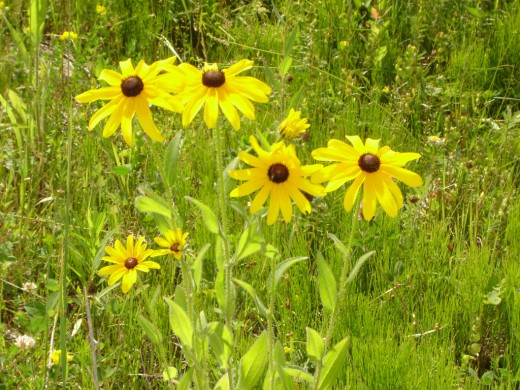
Reed flowers are golden yellow, tubular - small, brown, on a high receptacle. The variety Marmalade (height 60 cm) beautiful wide pointed reed flowers and dark tubular. Golden yellow inflorescences with a dark center resembling a star on a high peduncle (up to 60 cm) in the variety Meine freude. Wonderful dwarf variety Toto 20-30 cm high with rounded bright yellow marginal flowers and a dark center. There is a garden form of this type - rudbeckia beautiful, or two-tone ( R.h. var. pulcherima, syn. Rudbeckia bicolor) - a plant up to 60 cm high, inflorescences vary in size and color. The center is made of brown tubular flowers, and the reeds are yellow-red-brown.
Ursinia (Ursinia) - Another pretty elegant, but unfamiliar annual “daisy”. Ursinia umbilical, or dill, is the most popular in culture ( Ursinia anthemoides), - a highly branched bush 25-50 cm high.

Orange flower baskets (up to 5 cm in diameter) with a dark center and concentric red stains at the base of the reed flowers look spectacular against the background of strongly dissected, like dill, leaves. It blooms profusely from June to September. Flowers do not close in cloudy weather. Loves the sun and sandy soil. Can be used as ground cover. There are other types: ursinia beautiful ( Ursinia speciosa) with yellow tubular flowers and light golden reed (in the variety Albida - almost white); very small dwarf ursinia (Ursinia pygmea) 8-15 cm high with numerous small orange inflorescences.
Asters gave the name to the whole family, but the botanists refer to the genus of asters mainly perennial herbaceous plants, and the familiar asters that bloom at the end of summer are generally called Chinese callistephus (Callistephus chinensis). 
Callistefus Chinese, Autumn Astra (Callistephus chinensis)
This flower is so altered by breeders that it is difficult to find varieties with inflorescences similar to chamomile. But they are still there, for example, the Margarita variety: the center is yellow, and the marginal flowers are white, blue, pink in different shades. They look very good in a bouquet. Admiring them, not everyone recognizes callistefus in these colors. There are several dwarf varieties: Waldersee with a height of 20-30 cm with flat non-double inflorescences with a diameter of up to 3 cm; Edelweiss with a bush taller (up to 35 cm) and reed flowers up to 3 cm long. Wonderful is the Pepito variety with low cone-shaped bushes and baskets located as if in the same plane.
Of these asters, the following are most often grown:
alpine aster (Aster alpinus) - a plant that blooms in late May - mid-June. On strong stems 25-30 cm high, there are single baskets with a diameter of up to 5 cm. Reed flowers are purple, lilac, blue, white, tubular (in the center) - yellow. There are varieties: Alba (reed flowers are white), Goliath (large, light purple), Dunkle Chenet (dark violet), Rosea (pink), Glory (blue), Superbus (lilac - blue);
italian aster (Aster amellus) forms bushes of a hemispherical shape up to 60 cm high, completely covered with daisies with a diameter of 3-4 cm, collected in 8-10 pieces in loose corymbose inflorescences. Reed flowers are lilac-violet, tubular - yellow. It blooms from late July to October. Looks good in group landings. In the culture of many varieties with inflorescences of various shades of pink, blue, purple;
undersized shrub aster (Aster dumosus) is very good for borders. Strongly branched bushes-balls 20-50 cm high are beautiful even without flowers, and when flowering in August-October they are simply magnificent. There are varieties of different heights and different colors;
high (1.5 m) New Belgian aster (Aster novi-belgii) blooms simultaneously with shrubs. The bushes branch at the top and end with panicle inflorescences, sometimes numbering up to 200 baskets with a diameter of up to 4 cm;
new England aster, or American (Aster novae-angliae), blooms after all, from September to frost. Bushes reach a height of 2 m. People call these flowers Octobrins. Their sturdy stems are crowned with panicle inflorescences. Baskets with a diameter of 3-4 cm, tubular flowers in them are not only yellow, but also reddish and purple. Good for planting in the back rows of flower beds. Their late flowering decorates the garden in the fall.
![]()
Aster alpine (Aster alpinus)
Arktotis - a herbaceous perennial grown as an annual, also resembles chamomile flowers. He has single large baskets with a diameter of 5-8 cm on long sturdy peduncles. Regional reed flowers of light tones, tubular - dark blue. The shape of the inflorescence is very similar to gerbera.
The most popular arctotis is large, or stochasolistic (Arctotis grandis, Arctotis stoechadifolia) - wonderful silver-white daisies with a blue center, with gray-pubescent leaves. There is a variety of Shamakhanskaya queen with large inflorescences. New hybrids different kinds united in a group - arctotis hybrid (Arctotis hybridus). Reed flowers are yellow, orange, red, lilac, white, tubular - brown-purple or purple. The diameter of inflorescences is up to 10 cm, the height of plants is up to 70 cm. Arctotises easily propagate by seeds, like the sun and warmth. 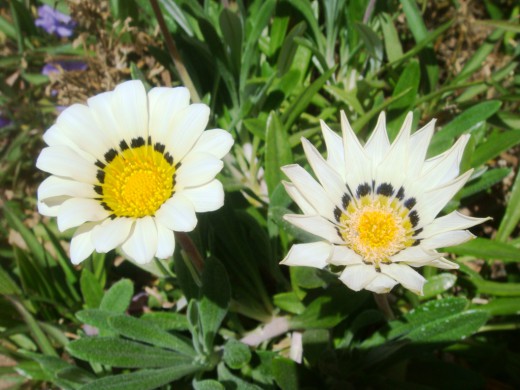
Arctotis (Arctotis)
Brachicome Iberisifolia (Brachicome iberidifolia) is a little-known annual plant, very elegant, stunted, with leaves dissected into narrow lobes. The bushes are covered with numerous small delicate daisies with a diameter of 3–3.5 cm, similar to daisies. Reed flowers are blue, lilac, purple, white, tubular - blue or almost black. Varieties of Iberisolata brachycoma: Vinta Splender (white tubular flowers), Ashes Splender (thick purple), Vrechi Blue (blue), Swan Lake (mixture). These delicate plants look good in containers or on the edge of the flower garden. 
Brachycome
In buzulnik, marginal flowers have the shape of reeds. They are mainly yellow, orange, and tubular - yellow or brown. These are large perennial rhizome plants with large leaves collected in a basal rosette. In the toothed buzulnik (Ligularia dentata), baskets 7-8 cm in diameter are collected in panicled inflorescences on peduncles up to 1 m high. In the Desdemona variety, the leaves below are lilac-brown, the flowers are orange, in the Othello variety - tangerine-orange, in Samm Gold - golden yellow. Wilson's Buzulnik (Ligularia wilsoniana) reaches a height of 1.5 m, baskets with a diameter of up to 2.5 cm are collected in very beautiful, powerful spike-shaped inflorescences. Buzulniki are good for solitary landings among the lawn. 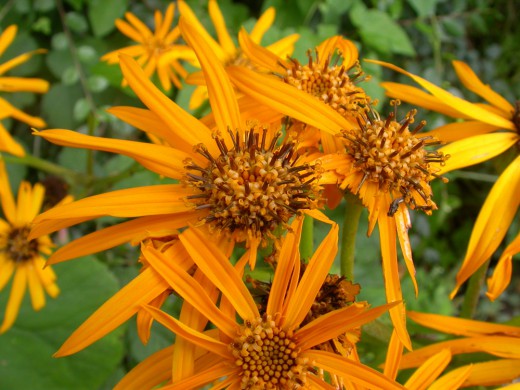
Buzulnik, Ligularia, or Ligularia (Ligularia)
Another original "daisy" - venidium. In its large baskets (up to 10 cm in diameter), purple-black strokes stand out at the base of each reed flower of white or orange color, and the convex center consists of black tubular flowers. Lush venidium (Venidium fastuosum) is generally spread - an annual herbaceous plant 60-70 cm tall, densely covered with white hairs. 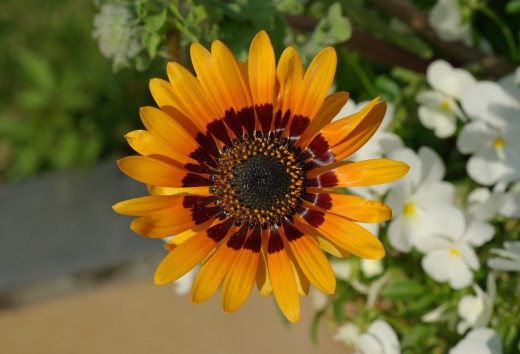
Venidium
It is very similar to the venidium of gatzania, only the reed flowers are wider, and at their base not strokes, but spots similar to the “eyes” of a peacock feather stand out. The most common gatzania hybrid (Gazania hybrid) is a perennial plant grown as an annual. The colors are very bright, elegant, there are a variety of combinations of colors. Gatsaniya is propagated by seeds, it grows relatively slowly, it is desirable to grow it in a seedling method. Planted by a group in a flower bed, gatsaniya is very pleasing to the eye. 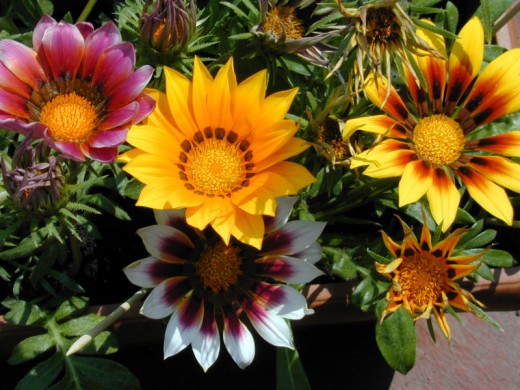
Gazania (Gazania)
© Zanchetta Fabio
Dahlia is a well-known flower to us, and among dahlias there are also similar in shape inflorescences to daisies. These are dwarf non-terry dahlias, in everyday life called Jolly Fellows, with wide white, yellow, orange, red, pink, raspberry reed flowers around the yellow center. Good for flower beds, rabatok. For group plantings, a high (90 cm) cultivar Heart Danko with bright red inflorescences 12-13 cm in diameter can be recommended. 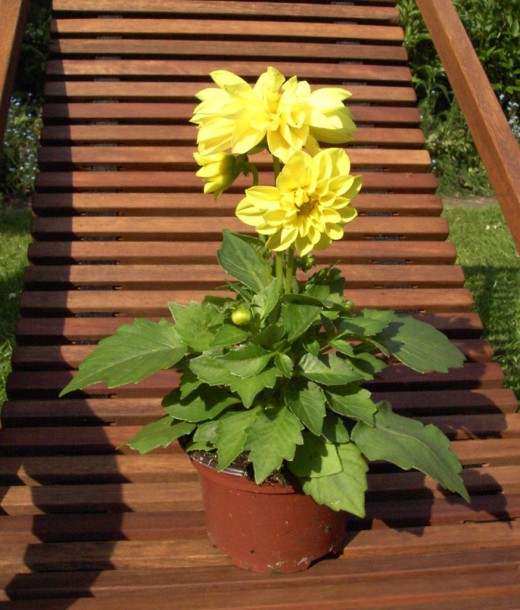
Dahlia (Dahlia)
One of the largest chamomile, of course, is a gerbera, the diameter of its inflorescences exceeds 15 cm. Numerous varieties are cultivated, derived from Gerbera jamesonii. The plant is perennial, light and thermophilic. In the south of Russia, it winters in the open ground, blooms from spring to late autumn. It blooms less abundantly in the middle lane; it does not winter in open ground. For the winter, a gerbera needs to be dug up like dahlias and stored in a cool, dry (4-5 ° C) place, it is better not to clear it from the ground (or in sand). 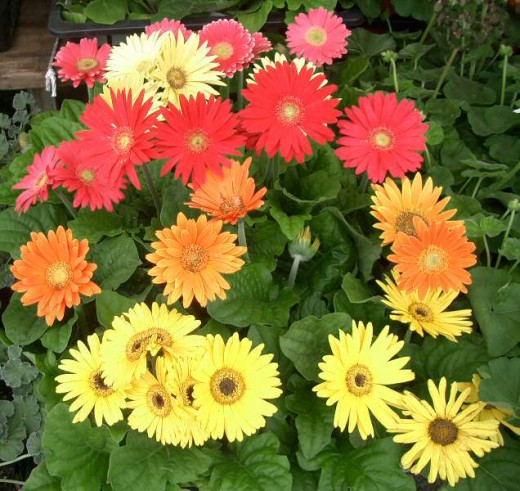
Gerbera
Dimorphotheque is one of the best soil-cover annual plants. It forms beautiful rugs with bright wide-open inflorescences sparkling in the sun (it is only a pity that they close in cloudy weather). Hybrid dimorphotheca (Dimorphotheca hybridum) with inflorescences with a diameter of 6-7 cm is widespread. Reed flowers are shiny, white, yellow, apricot, orange in color with dark tubular flowers in the center. There are varieties of Tetra Goliath with orange inflorescences up to 10 cm in diameter resembling a gerbera, Tetra Polyarstern with large white inflorescences with a purple center (they seem porcelain). Well propagated by seeds (they are recommended to be sown directly in the ground in early May). 
Dimorfotheca
Doronicum is the earliest daisy in the garden. Inflorescences-baskets with a diameter of 6-10 cm entirely golden yellow. It is a frost-resistant rhizome perennial. Most often, eastern or Caucasian doronicum (Doronicum orientale, Doronicum caucasicum) is found, 30-50 cm high. For alpine slides, a low (15 cm) grade Gold Dwarf, blooming before anyone else, is good. At the end of May, a higher (up to 80 cm) species blooms - plantain doronicum (Doronicum plantagineum). This species has a large-flowered form with stems up to 1.5 m high and inflorescences up to 10 cm in diameter. Doronikums are spectacular in group planting against shrubs. 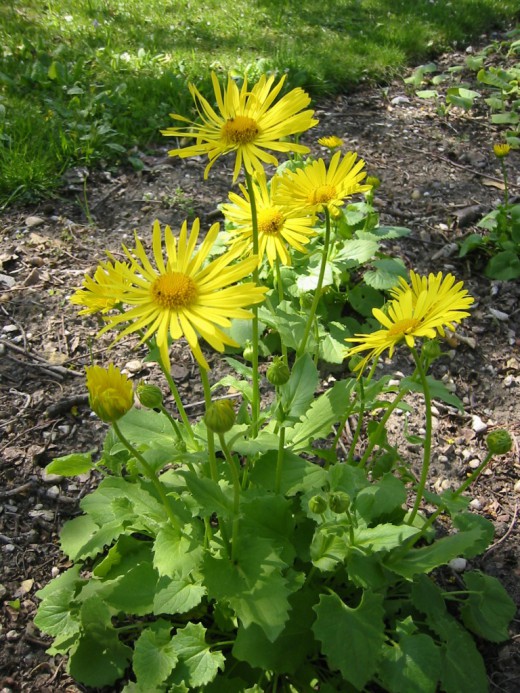
Doronicum
Dorotheantus is a flower of Dorothea, a short succulent perennial plant grown as an annual. Large variegated inflorescences open wide under the sun and can claim the title of the brightest annual. Look good among the stones on an alpine hill and in the form of large spots on the curb. Most often they sell seeds of dorotheanthus daisy (Dorotheanthus bellidiformis), or crystal mesembryanthemum (Mesembryanthemum cristallinum). Small fleshy leaves and stems of this plant are covered with shiny glandular hairs, which gives the impression of crystal grass. Inflorescences come in a wide variety of shades with a dark center. The varieties that NK Corporation offers are interesting: with sparkling white flowers (Rhinestone), with lilac (Amethyst), with yellow reed and red tubular (Marmalade). They reproduce well by seeds, but they must be sown early (in late February - early March). You can take queen cells for the winter in the house and in the spring cuttings. When sowing and grafting, overmoistening should be avoided. This plant blooms very abundantly and continuously, this is its advantage. 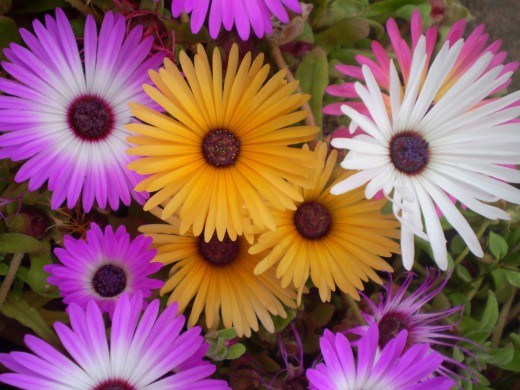
Dorotheanthus Marguerite (Dorotheanthus bellidiformis)
Daisy, of course, basically, daisy. Seeds of wild small perennial daisy (Bellis perennis) appear on sale - it is good for lawns. Among the non-terrestrial, one can name sortogroups of small daisies Liliput, Montrose.
Daisies can be propagated by seed and division of the bushes. They are used for lawns, borders, grown on balconies and in pots. 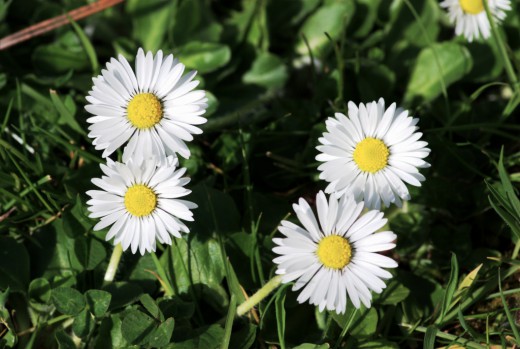
Perennial Daisy (Bellis perennis)
Small petals - a rhizome herb, similar to perennial asters. His "daisies" are distinguished by very narrow petals.
Beautiful petulite (Erigeron speciosus) up to 70 cm high with lilac inflorescences up to 4 cm in diameter and its hybrids with larger inflorescences and reed flowers of pink, lilac color are widespread.
It blooms in June. Less common is the small petal orange (Erigeron aurantiacus) - a plant 20-25 cm tall with orange inflorescences, blooming in June-July.
For alpine hills, a small pointed pebble (Erygeron mucro-natus) up to 20 cm high is suitable. The bush grows well with the help of underground shoots and fills the gaps between the stones.
Inflorescences-baskets as they age turn from white to deep pink, which gives the whole jacket a special charm.
In the middle lane this species does not winter well, but it can be grown as an annual as a border plant. Looks good in hanging vases.
All small petals are sun-loving, well propagated by seeds and division of the bush. Widely used for various flower beds and for cutting.

Small Arbor (Erigeron)
Aug 25, 2016 Galinka
There are many flowers similar to daisies. Among the most popular, one can distinguish rudbeckia, echinacea, erigerone (small petals), buzulnik, and, of course, everyone's favorite asters. All these flowers, like the daisies themselves, are irreplaceable in the landscape design of the garden. Especially if your site has a rock garden or rockery. The apparent simplicity of these plants is favorably shaded by ferns, conifers and other perennials.
Native Russian flower, chamomile is appropriate not only in the field, but also in the garden. Of course, this is not about a pharmacy daisy with small flowers, but about her larger sisters. These include plants with chamomile-like flowers. All of them, like chamomile, belong to the family Asteraceae. These plants, similar to chamomiles, although they differ in the names of species and even genera, but have much in common in their "habits."
On this page you will find out what the flowers are called, like colorful daisies, and how they look.
Garden flowers such as perennial asters are very similar to daisies.

For example, alpine aster (Asfer alpinus). Her flowers are painted in pink, blue, lilac and white colors, the latter are poured daisies, only a sprout of only 25 cm.
Alpine aster blooms in May, much earlier than daisies, but also magnificent and quite long.
But other types of asters bloom only in the fall, which can be credited to them, because at this time there are not enough flowers.

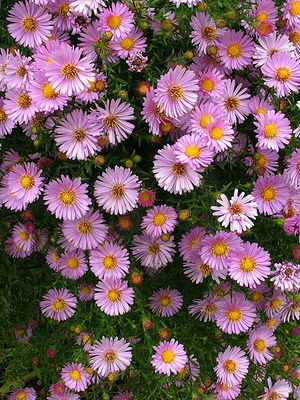
These are asters new English and new Belgian (A. nobo-angliae, A. novo-belgii). It’s already tall, and sometimes very tall, in human's height, bushes, powerful, fluffy. Do not ask me how to distinguish one from the other. Varieties of mass, they differ in terms of flowering and color of flowers.
Asters New England and New Belgian, perhaps, live longer than others. Their bushes become thicker and more voluminous from year to year. Only their middle can thin out a little.
These photos show flowers similar to daisies:


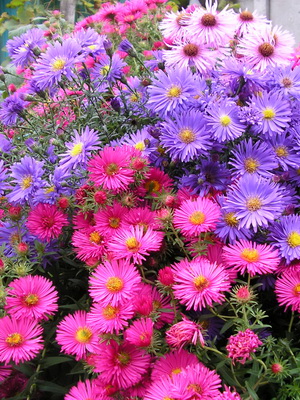

What other flowers look like daisies, and what are they called? Yellow daisies are, of course, buzulniki. Their "flowers" are collected in a variety of shields, panicles or brushes that adorn the garden throughout the second half of summer. Perhaps they are knocked out of the ranks of daisies in that they are more hygrophilous. Want a buzulnik? Get any! Species are extremely unpretentious, varietal with a purple leaf, too, only it is worth looking at spotted varieties so far.
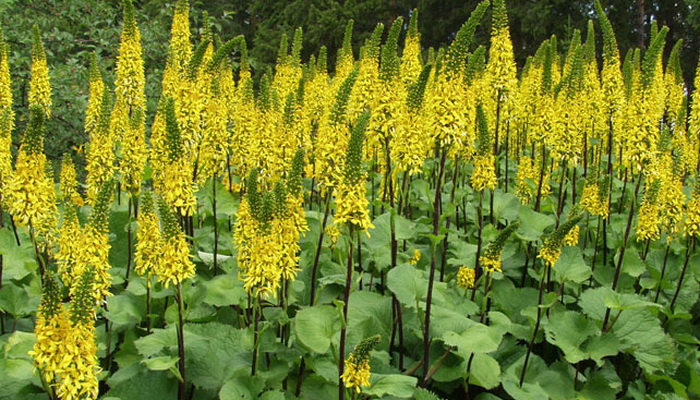
Most grow in a dense bush, but aggressors are also found - siberian Buzulnik (Ligularia sibirica).
Rudbeckia also look like yellow daisies. Here the most important size of the “flower” is that it is impressive in the rudbeck.
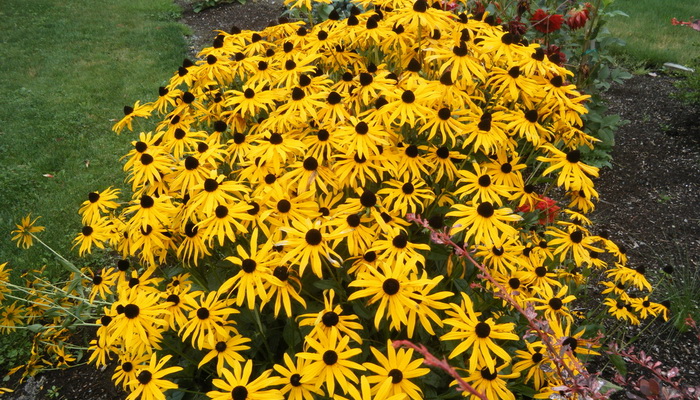
Mainly grown brilliant rudbeckia (Rudbeckia fulgida) and hybrid varieties in tan. Rudbeckias are generally short-lived; it is worth monitoring their periodic reseeding and division.
The following describes what other flowers look like daisies.
From multi-colored flowers similar to daisies, pink echinacea can be distinguished. Although why pink?
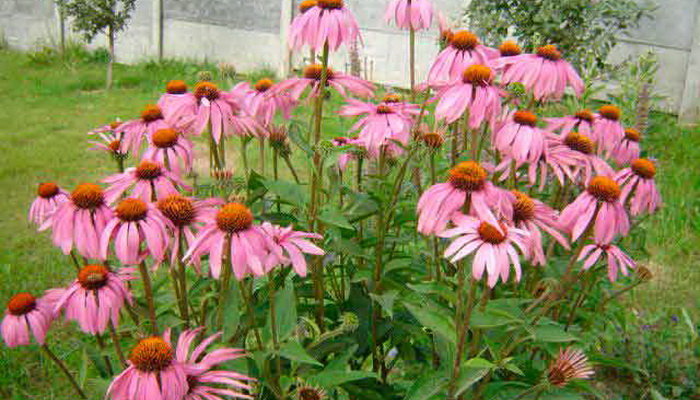
This is a species echinacea purpurea (Echinacea purpurea) flowers are dark pink.
And her varieties of which only shades do not! White, yellow, greenish, orange, pale pink, almost raspberry! And sometimes thick hemispherical midpoints, like pompons. Echinacea grows rather slowly, but they live longer than chamomiles. But it is desirable to divide them in three years.


Well, for a snack, tiny daisies for rock gardens. These are mountain small pebbles forming dense jackets pressed to the ground. Place them, of course, on a hill, among the pebbles, in the same rocky dump. There are many upland small-pebbles; many can be recommended, for example, Erigeron scopulinus.
It is better to divide and transplant chamomile-like flowers in spring, as soon as the snow has fallen. Then they will not even notice the execution and will bloom in the summer, as if nothing had happened. You can propagate daisies and seeds, this is easier than the lung: throw seeds into the ground - and they germinate. Seedlings develop smartly. When harvesting your seeds, keep in mind that Asteraceae have a large percentage of inferior seeds.
These are so unpretentious plants that it is difficult to notice pests and diseases on them. It happens that slugs spoil the foliage, it happens that in the wet year the chamomile partially rots. But usually these are trifles, not fatal for plants.
Look at the photo of flowers similar to daisies, the names of which are given above:
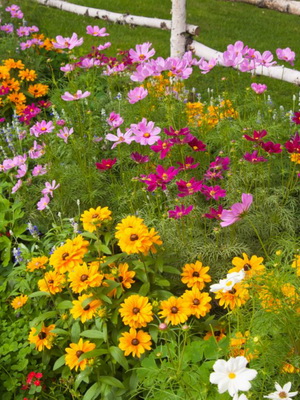
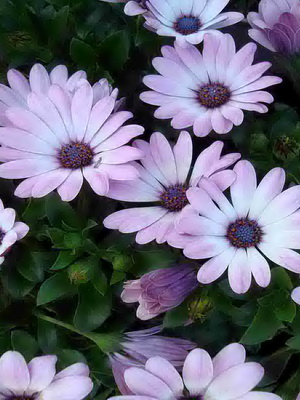
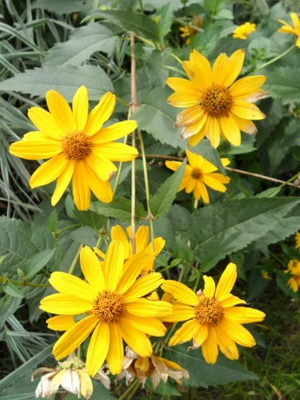
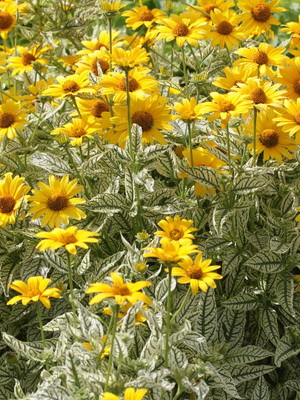
Daisies in the garden landscape design (with photo)
Well, now, actually about the daisy. What we take for a large flower with a yellow (most often) center is actually an inflorescence of two types of flowers: some, external, seem to us petals, others, internal flowers, we take for stamens. Actually, because the family is called so, that the flowers are so cunning, complex.
But in the culture of daisies are simple. Probably their only drawback is the relative fragility. They are growing rapidly, developing rapidly, but after three years they begin to grow. It is easily “cured” - by division.
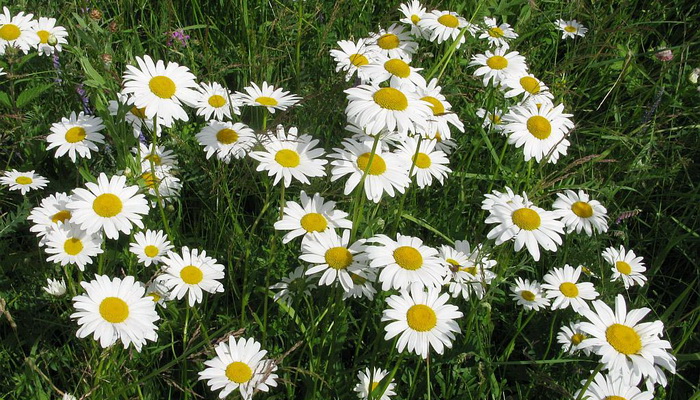
That white charm with a fragrant yellow center that is found in the fields and in the village front gardens, - meadow chamomile, or daisy (Leucanthemum vulgare).
It does not live long, but it sows itself - know only remove unnecessary seedlings. But in the design of the garden, such a daisy is indispensable - it adorns any flower beds with its radiant whiteness. No care. A similar daisy, only larger in size, is the largest daisy (L maximum). She is more fragile. She also has several varieties, of which terry is usually the most attractive.
Daisies are unanimous in relation to light: they love him, and it’s better to plant them in full sun. To eat daisies is also not averse, only on greasy soil they grow faster.
See how daisies look beautiful in landscape design in these photos:
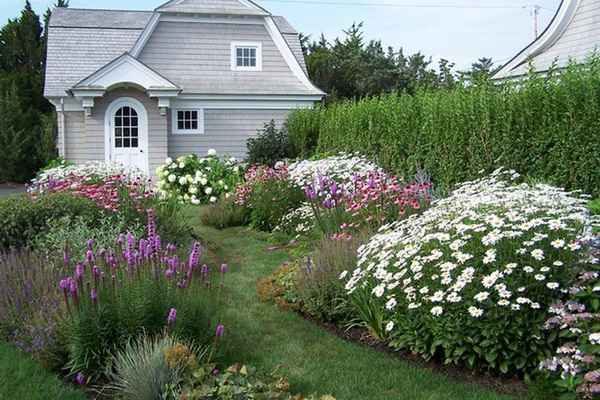

Among garden flowers, there are so many species daisy-like. An inexperienced grower is very difficult to understand their diversity. Below we will consider the most common of them.
Gerbera
- perennial plant from the family Asteraceae. Valued for long flowering and high decorativeness. Flowers with good care reach a size of 16 cm. They are also widely used for cutting.
There are many varieties of this plant, differing in size and shape of inflorescences. In recent years, even terry forms have been bred.
The color scheme of gerberas is very diverse. The color of the reed corollas can be the most diverse. Varieties with white, red and orange petals are found.
Care
Gerbera care is not particularly difficult. The following are its basic requirements:
- A large amount of sunshine, in the afternoon hours light shading is needed.
- Frequent but moderate watering.
- Soils must be selected with a slightly acid reaction.
- Faded inflorescences must be removed periodically. This stimulates the emergence of new ones.
- During a period of intensive growth, a complex mineral fertilizer is required.
Attention! When watering a gerbera, it is imperative to ensure that water does not accumulate in the center of the leaf outlet, as this will lead to decay of the leaves and death of the whole plant.
Yellow daisy

Doronicum
The scientific name for yellow daisy is doronicum. He comes from the family of asters. Doronicum with strong stems that are very resistant to lodging. Their height, depending on the variety, can be from 25 to 70 cm. The lower leaves are collected in a basal rosette.
Doronicum inflorescences are baskets of saturated yellow color. Their size can reach 10 cm. This plant blooms in spring for 1.5 months, in the shade a little longer.
Care
Doronicum is an unpretentious plant. But for full development, you need to follow a number of simple rules for caring for him:
- For planting, sunny areas are best suited, although it can successfully develop in shady places.
- The soil should be loose, without stagnation of moisture.
- In dry and hot weather, watering is required.
- In light snowy winters, additional shelter may be required.
Attention! The root system of the doronicum is superficial, therefore, it is not recommended to loosen with this plant.
Arctotis
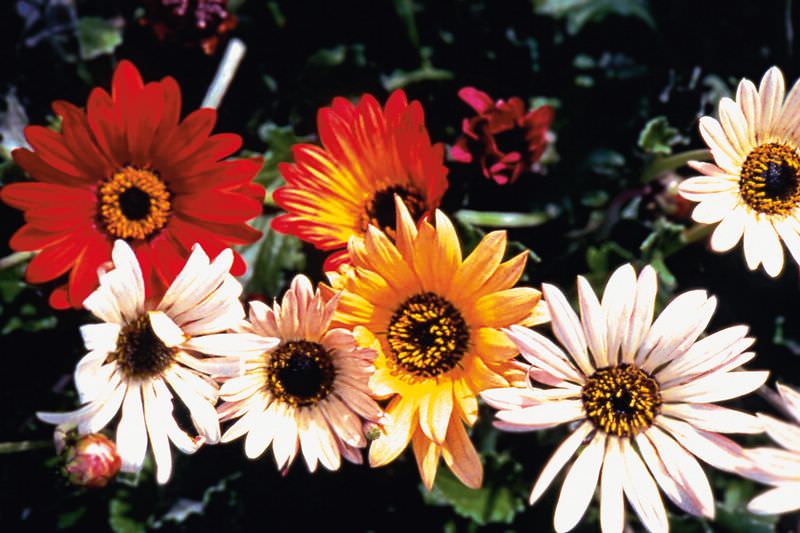
Arctotis
Arctotis is a representative of the family Asteraceae. It has massive stems, which, like the leaves, are covered with silver pubescence, which gives it additional decorativeness. The flowering period lasts from June to frost.
Flowers can be white, orange, red. Their diameter reaches a size of 10 cm. In rainy or cloudy weather they close.
Care
Arktotis, like any other culture, for successful growth requires compliance with the rules of cultivation:
- Watering is minimal, only in very intense heat. It is a drought tolerant species.
- For better tillering, pinching is necessary.
- Faded inflorescences need to be periodically removed, which, in turn, stimulates the appearance of new flowers.
Interesting! Arktotis can be grown as a perennial. To do this, the bushes dug in the fall are transplanted into pots and brought into the house. Where they winter successfully until spring.
Chrysanthemum
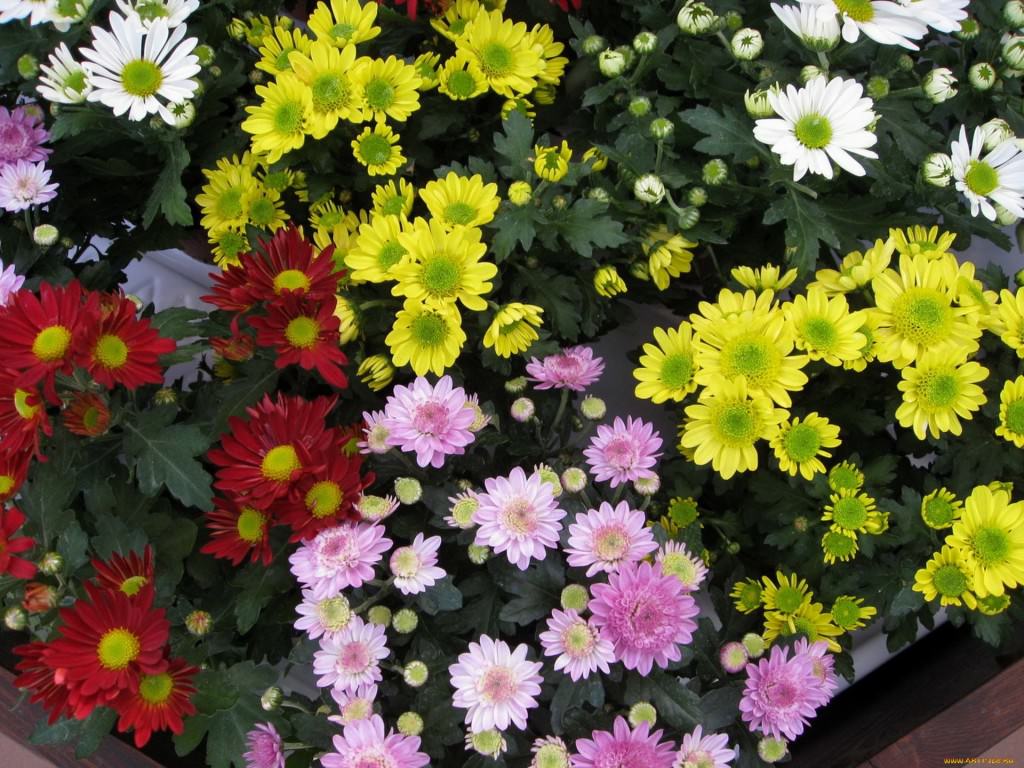
Chrysanthemums
Chamomile or, in another way, dendrantema. It is characterized by simple inflorescences in the form of chamomile. The number of rows of petals, depending on the variety, can reach from 1 to 4. Flowering occurs in the year of planting. Differs in very fast growth and unpretentiousness. The height of the bushes reaches 1 m.
According to the flowering period can be divided into early, middle and late. Duration depends on the weather and variety, but on average it is 25-30 days.
Care
In order for the chamomile chrysanthemum to please with abundant flowering, a number of conditions must be met:
- The location is better to choose a sunny, sheltered from the winds.
- Watering should be regular and always under the root.
- Every 3 years, overgrown bushes will have to be replanted.
- In cold, snowless winters, the chrysanthemum will have to be covered.
Interesting! Subject to the rules of growing on one bush, up to 50 flowers can be opened simultaneously.
Gazania
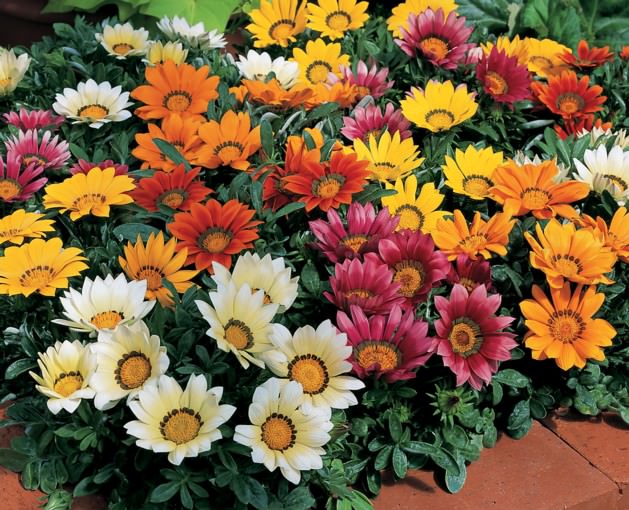
- A bright representative of the astrov family. A plant of this species is small in height; its leaves are collected in a basal rosette. Bottom of the leaf blades are covered with silver pubescence, which protects the gazania from the cold and helps prevent moisture loss during the heat.
The flowering period lasts from June to frost. All this time peduncles constantly appear from the middle of the outlet.
Inflorescences of gazania are baskets with petals of bright unusual coloring. They can be either plain or striped.
Care
For successful growth, development and abundant flowering, the rules for growing gazania are required:
- The location is sunny.
- Watering required moderate. Long waterlogging is fatal.
- The soil should be light and fertile with good drainage.
- During the season, fertilizing with fertilizers is necessary.
Leucanthemum

Leucanthem or garden chamomile - A widespread representative of the astro family. It is a perennial plant with erect stems, the height of which, depending on the variety, can reach 1.2 m.
Flowering takes place in 2 terms. The first time in May-June, the second at the end of summer. Flower baskets can reach a size of 10 cm. In the cut flowers last up to 10 days.
Care
For successful growth requires compliance with some subtleties in growing:
- The location should be sunny and open.
- The soil is light and nutritious, sandy and clay soils are not suitable at all.
- Watering is moderate. Excess moisture will cause an outbreak of fungal diseases.
Attention! To stimulate the repeated flowering of the leucanthemum, it is required to remove the faded peduncles.
Pyrethrum

Pyrethrum hybrid
Pyrethrum, he persian daisy, - a plant from the family Asteraceae. Its height can reach 70 cm. The stem of a Persian chamomile is straight with pinnate leaves. It is a herbaceous perennial.
Basket flowers with pink petals and a yellow middle. The flowering period falls in the middle of summer and under favorable conditions can last up to 2 months.
Care
Pyrethrum does not require any special care. The main thing is to observe the following conditions:
- The plot is suitable for both light and light partial shade.
- The soil is loose, especially with good drainage, otherwise the plant will freeze.
- Watering is moderate, only during prolonged drought.
- Plants need to be divided and planted periodically. This technique will avoid degeneration.
Interesting! Pyrethrum contains a special substance, pyrethrin, which is very toxic to insects.
Erigeron
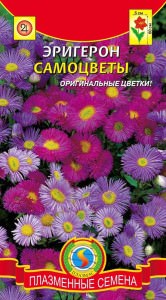
Erigeron
Erigeron or small petals refers to perennials from the aster family. Its spherical bushes, consisting of a huge number of branched shoots, can reach a height of 60 cm. Lanceolate leaves on the bush and more rounded at the base.
Baskets of flowers can be located either individually or in several pieces. Flowers can be pink, yellow or various shades of purple. Flowering begins in early summer and continues until late autumn.
Care
Erigeron does not require close attention and care. It is enough to observe the following conditions:
- The soil should be alkaline, always without stagnation of water.
- The plot is chosen sunny and well ventilated.
- Overgrown instances must be tied up.
Among the variety of garden flowers, daisies occupy a leading position. They fit perfectly into the flower beds of various types. And subject to elementary rules they will certainly thank agricultural technicians with plentiful and long flowering.
Chamomile is a perennial plant whose flower petals are always colored in white color. If you see multi-colored “daisies” on a flower bed, most likely these are gerberas.
Outwardly, the gerbera strongly resembles a camomile. Only the petals of her flowers can be painted in a wide variety of colors - yellow, pink, raspberry.
There are several dozen species of gerberas, most of which grow in Africa and Madagascar.
Discovery story
The first gerbera was described by the Dutch botanist Jan Gronovinus in the XVIII century. He named the flower after his friend the German botanist Traugott Gerber. Later, Karl Linney, engaged in the systematization of plants, used this name in his works. From the end of the 19th century, gerbera began to be widely cultivated.
Botanical Description
Gerbera, like chamomile, is a perennial plant. Unlike the latter, gerbera leaves are elongated, pointed at the end and grow from a basal rosette. Peduncles of this plant can reach a height of 60 cm. The flowers are collected in single inflorescences-baskets. Inflorescences of some types of gerberas can be up to 30 cm in diameter.
Gerbera is characterized by long flowering. Often a flower bed with these flowers pleases the eye for several months. Due to this feature, gerberas are often used in landscaping cities and summer cottages.
Gerber growing
Now gerberas are grown mainly in the form of hybrids. They are successfully cultivated in almost any climate zone. Due to the spectacular shape of the flowers, this plant is often used in bouquets. Cut gerberas can be stored in water for up to 20 days. So that they stand for a long time, it is recommended to pour only a small amount of water into the vase - so that the stem does not have time to rot.
More than 1000 varieties of gerberas are known, each of which differs in the form of inflorescences and the color of the petals. There are varieties with pink, white, orange, red, yellow, black colors. Breeders have not yet managed to achieve only one color of the gerbera's petals - blue. Some gerberas on one flower may contain petals of different colors.
Gerbera prefers to grow in a sunny place. It is necessary to water it so that the water does not fall into the root rosette of the leaves - otherwise the plant will rot and die.
If tall gerberas are good in the flowerbed, they prefer to grow dwarf varieties of this plant indoors. For the gerbera to bloom, it needs a short daylight and good ventilation.


